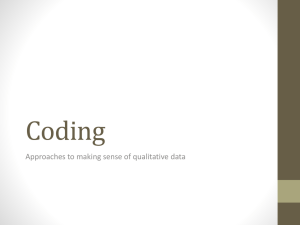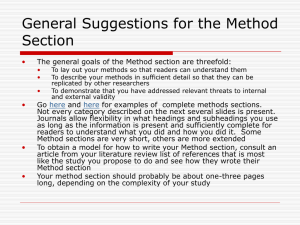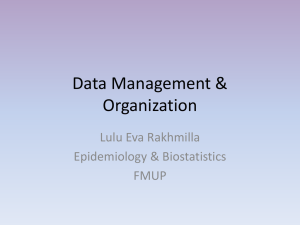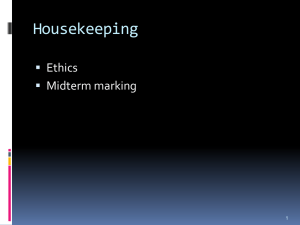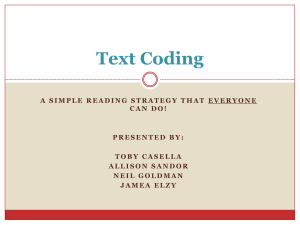Lecture 6: Qualitative Data Analysis
advertisement
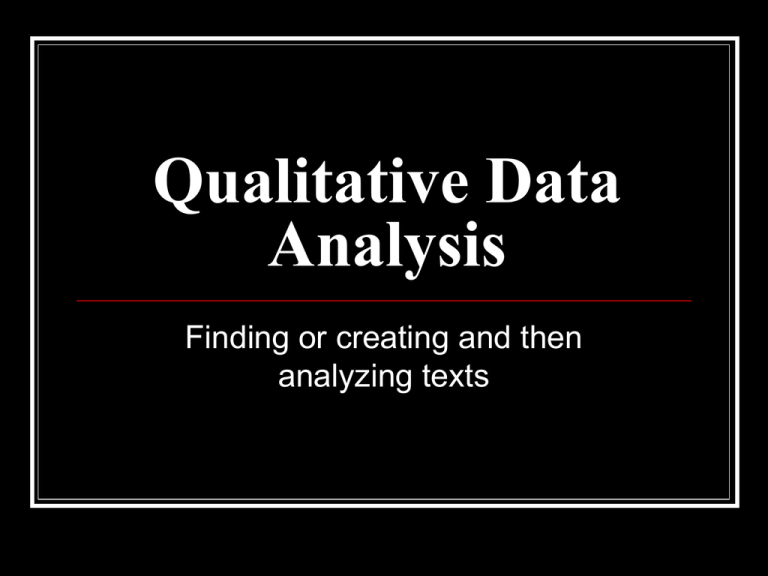
Qualitative Data Analysis Finding or creating and then analyzing texts The Coding Problem coding of texts and finding patterns. Coding turns qualitative data (texts) into quantitative data (codes) codes just as arbitrary as the codes we make up in e.g., the construction of questionnaires. Qualitative Inquiry Purpose - to produce findings. The Data Collection process is not an end in itself. The culminating activities of qualitative inquiry are analysis, interpretation, and presentation of findings. Challenge To make sense of massive amounts of data, reduce the volume of information, identify significant patterns and construct a framework for communicating the essence of what the data reveal Problem ‘…have few agreed-on canons for qualitative data analysis, in the sense of shared ground rules for drawing conclusions and verifying sturdiness’ Miles and Huberman, 1984) Critical Thinking ‘calls for a persistent effort to examine any belief or supposed form of knowledge in the light of the evidence that supports it and the further conclusions to which it tends’ (Glaser, 1941) - means weighing up the arguments and evidence for and against. Key points when thinking critically are (Glaser, 1941): Persistence: Considering an issue carefully and more than once Evidence: Evaluating the evidence put forward in support of the belief or viewpoint Implications: Considering where the belief or viewpoint leads; what conclusions would follow; are these suitable and rational; and if not, should the belief or viewpoint be reconsidered Analytical Thinking involves additional processes: Standing back from the information given Examining it in detail from many angles Checking closely whether each statement follows logically from what went before Looking for possible flaws in the reasoning, the evidence, or the way that conclusions are drawn Comparing the same issues from the point of view of other writers Being able to see and explain why different people arrived at different conclusions Being able to argue why one set of opinions, results or conclusions is preferable to another Being on guard for literary or statistical devices that encourage the reader to take questionable statements at face value Checking for hidden assumptions Checking for attempts to lure the reader into agreements The Credibility of Qualitative Analysis depends on three distinct but related inquiry elements: 1 2 3 Rigorous techniques and methods for gathering high-quality data that is carefully analysed, with attention to issues of validity, reliability, and triangulation; The credibility of the researcher, which is dependent on training, experience, track record, status, and presentation of self; Philosophical belief in the phenomenological paradigm, that is, a fundamental appreciation of naturalistic inquiry, qualitative methods, inductive analysis and holistic thinking. The Product of Qualitative Data Analysis "Naturalistic inquiry is always a matter of degree" extent to which the researcher influences responses and imposes categories on the data. The more "pure" the naturalistic inquiry, the less reduction of data into categories. Bogdan and Biklen "working with data, organizing it, breaking it into manageable units, synthesizing it, searching for patterns, discovering what is important and what is to be learned, and deciding what you will tell others" (1982:145) challenge – to place the raw data into logical, meaningful categories; to examine them in a holistic fashion; to communicate this interpretation to others. Common stages of analysis Familiarisation with the data through review, reading, listening etc. Transcription of tape recorded material. Organisation and indexing of data for easy retrieval and identification. Anonymising of sensitive data. Coding (or indexing). Identification of themes. Re-coding. Development of provisional categories. Exploration of relationships between categories. Refinement of themes and categories. Development of theory and incorporation of pre-existing knowledge. Testing of theory against the data. Report writing, including excerpts from original data if appropriate (e.g., quotes from interviews). 3 broad levels of analysis that could be pursued Simply count the number of times a particular word or concept occurs (e.g., loneliness) in a narrative: The qualitative data can then be categorised quantitatively and subjected to statistical analysis. For a thematic analysis want to go deeper than this. All units of data (eg sentences or paragraphs) referring to loneliness could be given a particular code, extracted and examined in more detail. Do participants talk of being lonely even when others are present? Are there particular times of day or week when they experience loneliness? In what terms do they express loneliness? Do men and women talk of loneliness in different ways? Are those who speak of loneliness also those who experience depression? Themes could eventually be developed such as ‘lonely but never alone’ or ‘these four walls’. For a theoretical analysis such as grounded theory you would want to go further still. 1. Analysis Considerations 1 2 3 4 5 6 7 Words Context (tone and inflection) Internal consistency (opinion shifts during groups) Frequency and intensity of comments (counting, content analysis) Specificity Trends/themes Iteration (data collection and analysis is an iterative process moving back and forth) Grounded theory – constant comparative method open coding (initial familiarisation with the data) delineation of emergent concepts conceptual coding (using emergent concepts) refinement of conceptual coding schemes clustering of concepts to form analytical categories searching for core categories core categories lead to identification of core theory Analysis begins: identification of the themes emerging from the raw data, "open coding" (Strauss & Corbin 1990) identify and tentatively name the conceptual categories into which the phenomena observed will be grouped. goal - to create descriptive, multi-dimensional categories which form a preliminary framework for analysis. Raw data are broken down into manageable chunks, and researcher devises an "audit trail". Next stage of analysis: Re-examination of the categories identified to determine how they are linked: "axial coding“. Discrete categories identified in open coding are compared and combined in new ways as the researcher begins to assemble the "big picture." Purpose of coding not only to describe but to acquire new understanding of a phenomenon of interest. During axial coding the researcher is responsible for building a conceptual model and for determining whether sufficient data exists to support that interpretation. Finally: Researcher translates the conceptual model into the story line that will be read by others. Research report should be a rich, tightly woven account that "closely approximates the reality it represents". Stages of analysis not necessarily linear, in practice occur simultaneously and repeatedly. RULES OF DATA ANALYSIS 1 Timing of Analysis a) in relation to data collection following data collection = linear continuing, interactive (e.g., constant comparative analysis) in a matrix b) in relation to phases of study cyclical approach to data collection and analysis specified in some designs - (e.g., action research, case study, cooperative inquiry). Interim analysis. 2. Separability of Data a) abstraction of ideas/concepts from 'raw data' during analysis b) interaction between different datasets, e.g., 'melting pot' of all data vs. each tranche analysed separately c) combination - when and how datasets may (or must) be combined or separated 3. Admissibility of Data a) relative value or worth of different kinds of data and how it is assessed b) validation required (and how) or not, e.g., by members, research participants, other researchers, etc. Analytic Principles Coding data: Mark, corral, and reduce data. Start with codes a priori or allow to develop. Codes evolve with time and experience. Analyzing data and codes: Mimic quantitative by counting, correlating. Reduce data and focus analysis. Proliferate codes to see layers of meaning. Computer Assistance Does not alter analysis process. Usually not a shortcut or timesaver. Programs fit different data & needs. Computer Software Atlas-ti: large datasets, unstructured coding, mimic paper code & sort. NUDIST: large datasets, structured coding, mimic quant analysis. NVivo: less data, unstructured coding, find patterns/relationships in codes. Folio Views: huge datasets, focused coding, search & sort. 6 types Word processors Word retrievers Textbase managers Code-&-retrieve programs Code-based theory builders Conceptual-network builders Practical Advice Start the analysis right away and keep a running account of it in your notes Involve more than one person Leave enough time and money for analysis and writing Be selective when using computer software packages in qualitative analysis The Qualitative Analytical Process (Adapted from descriptions of Strauss and Corbin, 1990, Spiggle 1994, Miles and Huberman, 1994) Components Data Reductions Data Display Conclusions & Verification Procedures Coding Categorisation Abstraction Comparison Dimensionalisation Integration Interpretation Outcomes Description Explanation/ Interpretation


